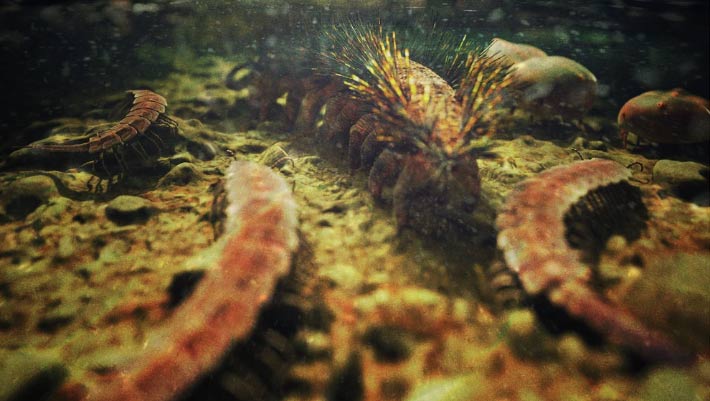
Long-Misidentified Fossil is First Known Nonmarine Lobopodian, Paleontologists Say
How did your country report this? Share your view in the comments.
Diverging Reports Breakdown
Long-Misidentified Fossil is First Known Nonmarine Lobopodian, Paleontologists Say
Palaeocampa anthrax most likely inhabited a freshwater environment, contesting view that Paleozoic lobopodians were exclusively marine. Discovery also resolves mystery of France’s Montceau-les-Mines fossil site, once considered as marine. Find raises new evolutionary questions: How many others made the leap from marine to freshwater and could more be hiding, misidentified, in museum drawers? “I’m thrilled this technique possessed the sensitivity and specificity to differentiate fossilized remains from the rocky substrate,” said Columbia University paleontologist Nanfang Yu. “Most of our insights come from Cambrian Lagerstätten, but the Carboniferous period … offers far fewer such windows, making every new find incredibly valuable,’ Dr. Knecht noted. ‘The conditions required to fossilize soft-bodied creatures like lobopods are rare.’
Lobopodians are extinct, soft-bodied creatures that bridge the evolutionary gap between a primitive worm-like ancestor and modern arthropods like insects and crustaceans.
Known mostly from Cambrian marine deposits such as the Burgess Shale, they include iconic fossils like Hallucigenia and Aysheaia pedunculata discovered in 1911, and were thought to be exclusively marine — until now.
“Lobopodians were likely a common sight on Paleozoic sea beds, but apart from microscopic tardigrades and terrestrial velvet worms, we thought they were confined to the ocean,” Dr. Knecht said.
In new research, Dr. Knecht and co-authors analyzed 43 specimens of Palaeocampa anthrax from two Carboniferous Lagerstätten — Mazon Creek in the United States and Montceau-les-Mines in France — using advanced imaging, including backscatter scanning electron microscopy (SEM) and energy-dispersive spectroscopy.
They revealed exquisite anatomical features — most notably, nearly 1,000 bristle-like spines covering the body.
Using Fourier-transform infrared spectroscopy (FTIR), they also detectedchemical residues at the spine tips — suggesting the spines secreted toxins to deter predators in its swampy habitat.
“What amazed me is that fragments of biomacromolecules could be exceptionally preserved or altered to geomacromolecules in fossils,” said Columbia University paleontologist Nanfang Yu.
“I’m thrilled this technique possessed the sensitivity and specificity to differentiate fossilized remains from the rocky substrate.”
According to the team, Palaeocampa anthrax’s closest relative is Hadranax, a Cambrian lobopodian from Greenland, nearly 200 million years older.
Both had ten pairs of legs, no claws and were blind; but while Hadranax was unarmored and navigated the deep sea using elongated frontal appendages, Palaeocampa anthrax, at just 4 cm long, bore a dense coat of spines — arranged above each pair of legs, giving it a fuzzy caterpillar-like appearance — and inhabited freshwater, possibly amphibious, environments.
The discovery also resolves the mystery of France’s Montceau-les-Mines fossil site, once considered as marine.
“Mazon Creek is a mix of terrestrial, freshwater, and marine animals,” Dr. Knecht explained.
“But, Montceau-les-Mines, where half of the specimens come from, was hundreds of km inland, with no ocean present.”
“Its reclassification confirms the site’s nonmarine setting, offering a rare glimpse into ancient freshwater ecosystems.”
This discovery broadens our understanding of lobopodian diversity and raises new evolutionary questions: How many others made the leap from marine to freshwater and could more be hiding, misidentified, in museum drawers?
“The conditions required to fossilize soft-bodied creatures like lobopodians are rare,” Dr. Knecht noted.
“Most of our insights come from Cambrian Lagerstätten, but the Carboniferous period — when Palaeocampa anthrax lived — offers far fewer such windows, making every new find incredibly valuable.”
The results appear in the journal Communications Biology.
_____
R.J. Knecht et al. 2025. Palaeocampa anthrax, an armored freshwater lobopodian with chemical defenses from the Carboniferous. Commun Biol 8, 1080; doi: 10.1038/s42003-025-08483-0
Source: https://www.sci.news/paleontology/palaeocampa-anthrax-14089.html
